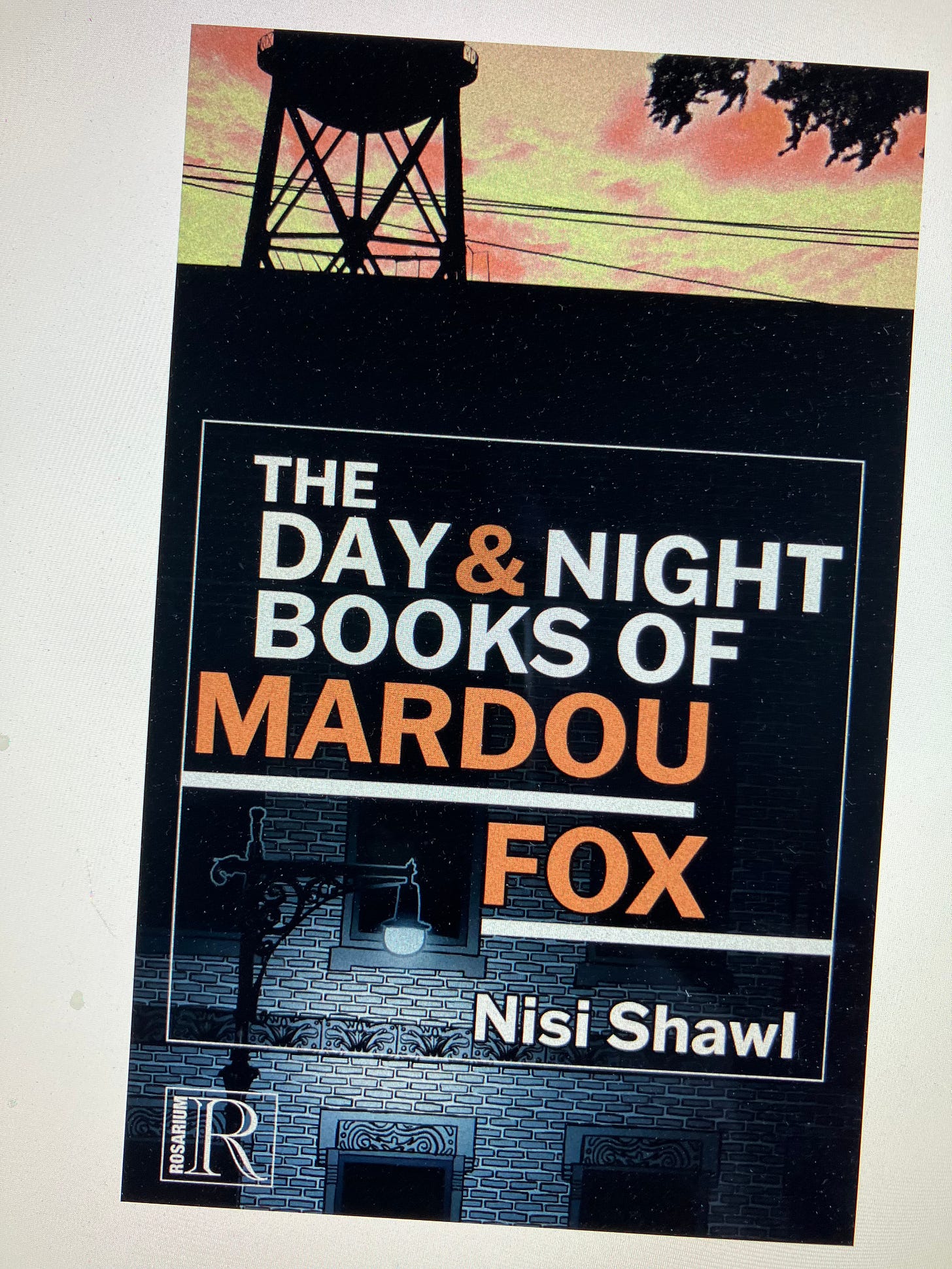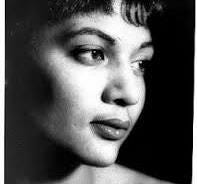Interview #37: Nisi Shawl
Fresh speculation on Kerouac lover
JACK KEROUAC’s 1958 novella The Subterraneans, originally the subject of critical acclaim has been a much more divisive text in more recent times. Its approach to issues of race – the central tale concerns a love affair between a white man and a black woman – is now regarded as problematic and that controversy has helped relegate it to the literary shadows.
However, the versatile and prolific writer Nisi Shawl prompts us to return to the topic through a radical means: a reimagining of the book’s heroine Mardou, presenting her as much more than the passive participant in a short biracial romance and rather a woman who emerges from that fleeting tryst as a writer, on her own terms with her own aspirations.
The Day & Night Books of Mardou Fox, recently issued by Rosarium Publishing, is a bold remaking of Kerouac’s earlier myth, utilising a style with which Shawl has become closely associated – speculative fiction.
We review the book elsewhere in the pages of Rock and the Beat Generation with Ann Charters, the grande dame of Beat Studies providing her assessment of the title. To support that article, we are delighted to interview Nisi Shawl about that book, their take on Kerouac and the Beats and their interest in music, particularly jazz.
Shawl’s biography is rich and varied, their output not confined to one particular style. They are a multiple award-winning author, co-author, editor and co-editor of over a dozen books of speculative fiction and related nonfiction, including the standard text on diverse representation in literature: Writing the Other: A Practical Approach.
Picture above: Author Nisi Shawl
The novel Everfair was a Nebula Award finalist, the first two volumes of the acclaimed New Suns anthology series and the short story collection Filter House, co-winner of the 2009 Otherwise Award, are further indications of their range.
A regular speaker at institutions of learning, including Duke University, Spelman College, Stanford University and Sarah Lawrence College, their recent titles have included a horror-adjacent collection, Our Fruiting Bodies; the Middle Grade historical fantasy novel Speculation; and Kinning, a book-length sequel to Everfair.
Shawl lives in Seattle, ‘one block away from a beautiful, dangerous lake full of currents and millionaires.’ Simon Warner, R&BG’s Founding Editor, shared a conversation with the author…
____________________________________________________________________________
Simon Warner: Did you have an interest in Beat Generation topics before you embarked on your Mardou Fox book? How did Alene Lee, the real life inspiration for Kerouac’s story, become such a cause célèbre you? What drew you to her story in the first place?
Nisi Shawl: In my late twenties and early thirties I read a bunch of Beat fiction. I met Michael McClure at a poetry reading. I hung out a few times with Edie Kerouac Parker. But then I began to focus more and more fiercely on science fiction, fantasy and horror, and my interest in the Beats dwindled. It never went completely away, though. And then I learned about feminist authors and how they would sometimes retell a familiar story from the perspective of a marginalized character – think of Jean Rhys’s Wide Sargasso Sea, for instance.
Discovering that the real-life counterpart of Kerouac’s heroine ‘Mardou Fox’ was also an author, though a less successful one, led me to believe she would have told the tale of their interaction quite differently than he did. And so I tried to imagine what that telling would be like. That was the start of the project. It went on from there, of course, becoming stranger as it developed.
SW: What do you feel is the role of speculative fiction? Would you please say something about the genre and explain its intentions? How did you apply those techniques to the Mardou Fox project?
NS: The role of speculative fiction is a big old role that people smarter than me have written entire books about. I can only say that it’s one of the means I use to question dominant paradigm-aligned assumptions about how the world works. In the case of my book about Mardou Fox, I constructed a world matching fairly closely to our own, but in which this Alene Lee stand-in lived a life, which was much more successful than the original’s in lots of ways: she marries a man who loves her, she enjoys a career as a renowned writer, she learns to travel magically between realities…
Pictured above: Nisi Shawl’s latest title
The technique I use throughout The Day & Night Books of Mardou Fox is that of mixing descriptions and actions as evocative of actual experience as possible with wild yet thoughtfully imagined ‘What ifs’. What if the ‘many worlds’ hypothesis was right, and each decision we made split the universe into infinite instances? What if there was a centuries-old social movement teaching how to deal with these decisions called ‘The Five Petals of Thought’? What if we could communicate with our younger selves?
SW: You commemorate Alene Lee when you speak at public events by performing Annie Ross’ ‘Twisted’. Tell us a little more about that tribute and the choice you make. Is music important to your creative process?
NS: Music is crucial to my creative process! I’ve written and sung songs onstage as part of post-punk bands – the Insex and Accidental Suitcase – and I almost always listen to music as I work. I sing at my readings to let people know there’s something special about to happen. I once told a group of other authors that my ambition is to write something that does to readers what Wayne Shorter’s ballad ‘Infant Eyes’ does to listeners.
‘Twisted’ seemed to me to be the obvious pick to accompany excerpts of The Day & Night Books of Mardou Fox for several reasons: it’s jazz, which was an important art form in Beat reckoning; it’s from roughly the same period as much of the novella’s action; it’s given in a female voice; and it talks about a visit to a therapist (Mardou goes to her therapist, Dr. Dee, in the book’s last half). Plus, it’s a lot of fun to sing.
Pictured above: Alene Lee, the real-life Mardou Fox
SW: Some feel there was a racist subtext to some of Kerouac’s writings and attitudes. Was he maybe identifying an enduring heroism and a lust for life in the black culture of mid-century America? Or was he a naïve romantic who little understood the reality of that world?
NS: It has surprised me how negatively my readers view Leo Percepied, my Kerouac stand-in. By that character’s lights he was treating Mardou extremely well, and I honestly think it would have been weird if he hadn’t exhibited any racism at all. Same for the real-life man. He was sensitive, an artist, and steeped in the beauty of a primarily Black art form, jazz. He was also basically surrounded by racist ideology and – perhaps unconsciously – soaking it in his whole life.
Both his romanticising and his exoticising of racial subjects are quite evident to me, and very likely evident to any person of color reading his raves and yearning disquisitions. I’m not repeating the infuriating excuse that he was ‘a man of his time’. My grandfather was a man of the same time, and I know he had a better understanding of race. All I want to say in Kerouac’s defence is that he had problems in this area, yes, but that those problems could have been far, far worse.
SW: In The Subterraneans, Kerouac appears to elevate or, to return to that idea previously expressed, is it to merely exoticise his black lover. How do you perceive the relationship?
NS: I perceive the relationship between Kerouac and Lee/Fox in The Subterraneans as largely a figment of the author’s imagination. The story goes that when he proudly showed Lee its MS she was livid with anger. Remember, their affair only lasted a couple of months. Misunderstanding as its major underpinning explains that; her romantic relationship with Kerouac’s friend Lucien Carr went on for years.
SW: When the book came to be made into a film in 1960, the two principal actors were no longer the biracial protagonists of the source story but were now both white. What is your response to that?
NS: My reaction to the cinematic transformation of Mardou Fox into a white woman was and is resigned disgust.
SW: Is it time to remake that cinematic version and and celebrate the person of color at the very heart of the drama?
NS: I don’t actually want to see that. Kerouac’s version of events is most likely divorced just far enough from the truth that additional promotion of what he wrote is confusing and unhelpful. I would rather see a film or streaming series made of my book – not simply because it’s mine, but because it has the advantage of departing very clearly and consciously from what’s known about what went on.
The Day & Night Books of Mardou Fox is not only fiction, it’s fantasy. It’s inspired by Kerouac and Lee – and Ginsberg, Corso, Cassady and other Beats – but it’s pretty obviously not those people’s history.
SW: The original love affair was so taboo, of course, that Kerouac attempted to disguise his tracks by placing the romance in San Francisco rather than the New York in which it had really bloomed. Do you have any thoughts on that?
NS: Was that why he translocated the action like that? Out of shame? Out of fear? Was interracial love what he wanted to disguise – not drunk driving or drug injections or any of the other illegal activities he chronicled? Is that so? Then guess what thoughts I’m having.
SW: Are the African American Beat poets – LeRoi Jones/Amiri Baraka, Bob Kaufman, Ted Joans – of interest to you as a writer as a cultural historian? Or is feminism and the re-positioning of women's stories in the tapestry of the past your principal motivation?
I know of Jones/Baraka, and was fortunate enough to read his work while he was still alive and writing. Kaufman and Joans are new names to me. My knowledge of this period is nowhere near as deep as yours. They all sound interesting, but here’s what I’m really moved by: the prospect of writing another novella featuring Mardou. I have a rough outline and a title in mind: ‘On and Over the Fence with Mardou Fox’. Let’s see if I get to get to it.
See also: ‘Book review #49: The Day & Night Books of Mardou Fox’, May 30th, 2025




